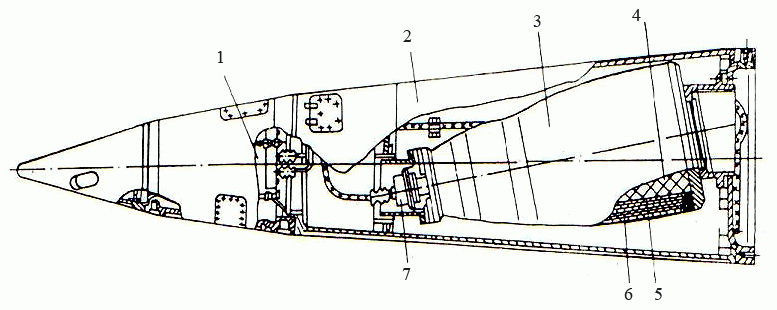The 9H123F combat unit is designed to hit targets with shrapnel and blast action.
- non-contact explosive device (NED) 9E118
- case 9H310
- charge case
- explosive charge
- glass fibre
- combat troops
- safety actuator (PIM) 9E117 two contact sensors 9E128
Body 9H310 - thin-walled aluminum alloy with bends front and rear. A radio sensor in a radio-transparent tip is attached to the front bends, a missile part is connected to the rear and a combat charge is attached. In addition, the casing has a partition inside which there is PIM 9E117 connected to the combat charge. Inside the casing there is a cable that connects the RF control system with the radio sensor. In the case there is a combat charge deployed at an angle of 10° to the longitudinal axis of the RF. On the combat charge there is a glass fiber or glass tape with 3 types of combat elements glued in two rows.
PIM 9E117 is designed to ensure safety during service handling of the BC and to provide impulses to the detonator of the combat charge from a non-contact fuse device (from a laser sensor) or contact sensor BC.
PIM 9E117 is an electromagnetic device with 2 stages of protection:
- 1 stage - removed at the moment of missile launch, structurally designed as an electromagnetic contactor.
- 2 stage - removed at a given height (18-4km) in the descending section of the trajectory on command from the control system. The executive element of a stage is an engine with a pyrotechnic pusher.
The non-contact fuse device 9E118 includes a radio sensor and a laser sensor. The 9E118 HLU is designed to issue a command to the SC to turn the missile on target at an angle of 80 ± 5° at an altitude of 450 ± 50m, as well as issue a command to detonate the BC when reaching a height of 15 ± 6 m from the Earth's surface.
9E118 consists of two independent sensors:
- Radio sensor 9E326 is designed to give a command to turn the missile at an altitude of 450 ± 50m. The radio sensor is an active radar device with a pulse principle of action and has one receiving antenna. 9E326 is activated at an altitude of 18-4km depending on the launch range. The transmitter generates a radio signal at a certain frequency. This signal is fed to the receiving and transmitting antenna. The antenna sends the signal towards the target (ground surface), the reflected signal is picked up by the receiving and transmitting antenna. The reflected signal is received by the receiver through a high-frequency switching unit, where the signal is analyzed using a resonance loop. Once the frequency of the reflected signal, and thus the height of the flight will be equal to a given height (450 ± 50m) is excited by the resonant circuit, in which there is a maximum current, and then triggers a relay in the power supply unit of the radio sensor (relay closes the contacts through which the command to turn the missile to the target. The frequency is changed by a random law.
- Laser sensor is designed to give a command to blow up the BC at an altitude of 15 ± 6m. Transmitting optical system and receiver are lenses of "Zenith" camera. Transmitting device - laser, receiving device - photo-transistor or photodiode. The laser sensor is switched on at an altitude of 18-4 km depending on the launch range simultaneously with the 9E326 radio sensor. It starts to emit waves of optical range of a certain frequency. The laser sensor generates a beam of light which is focused by the optical system, the beam is sent to the ground, reflected from it, enters the receiver of the optical system, where it is also focused, and then enters the photo-transistor. At an altitude of 15±6m the beam reflected from the ground will be so strong that it will trigger the phototransistor and the power supply relay, the relay will close the contacts through which the signal to the PIM electro-detonator will be received.
The 9E128 contact sensor is designed to generate an electrical signal when the missile encounters an obstacle and then transmits this signal to the PIM. It is a permanent magnet, which moves in the coil.
Tactical and technical characteristics
| Weight of BC,kg | 482 |
| Number of splinters | 14500 |
| Weight of explosive (TG20 TNT hexogen), kg | 162.5 |
| Types of splinters: - 1 group mass 20.6g - 2 group mass 10.0g - 3 group mass 5.47g |
6000 4000 4500 |
| Diameter,mm | 650 |
| Surface area, ha. | 2-3 |
